Welcome to the world of the ultimate vegetarian comfort food in the form of cheesy, flavorful pasta.

You know my favorite kind of dinner recipe is one that consists of carbs and cheese, right? Like this Cheesy Baked Spaghetti or creamy spinach tomato gnocchi.
My love of this has no bounds. Which is exactly why I am so very excited to share with you my all-time vegetarian lasagna recipe today. It’s easy to make, and while it requires a few steps, it comes together relatively quickly. Maybe not quite as quickly as our baked ziti, but it’s worth the effort.
I’m sharing two methods with you. The first, a quick-prep method using store-bought no-boil lasagna noodles. The second, a labor of love, made with homemade fresh pasta sheets — more on this to come.
For now, sit back, pour yourself a glass of wine in preparation, and let’s get to making lasagna!
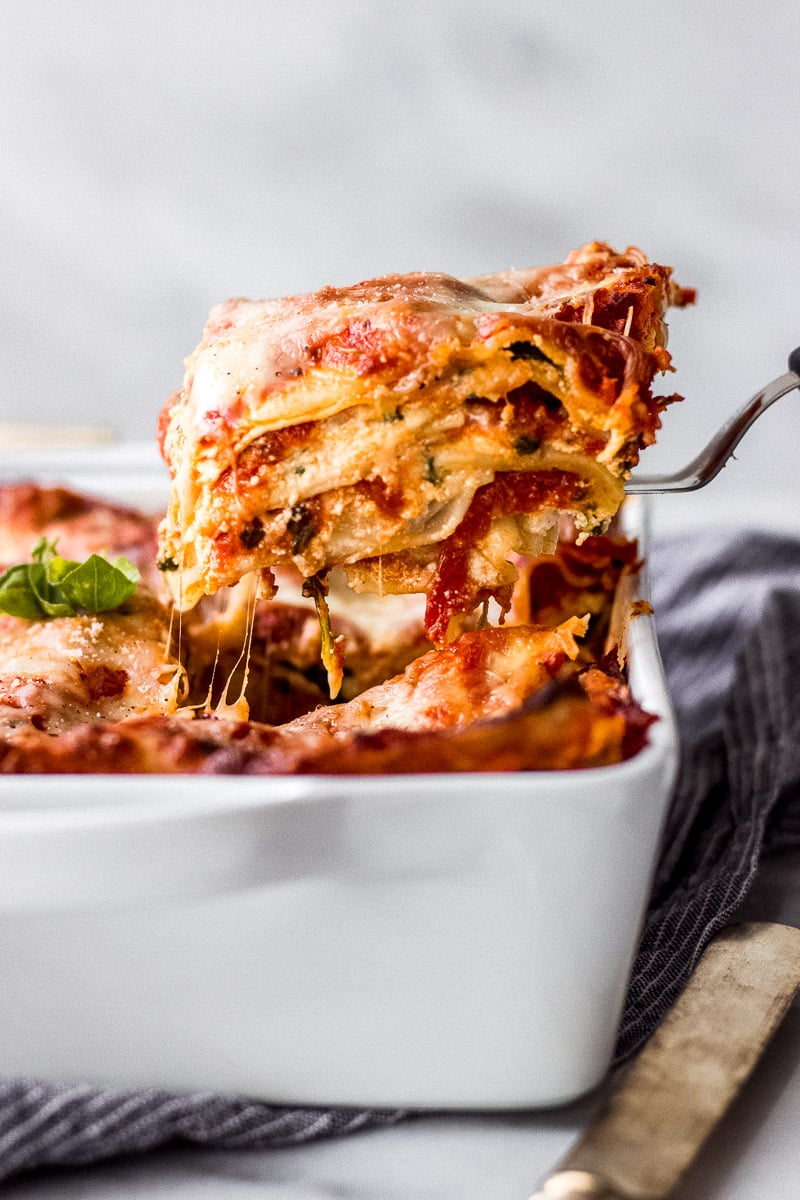
Ingredients for Vegetarian Lasagna
This vegetarian lasagna consists of three parts: the pasta, the ricotta spinach filling, and the tomato sauce. Oh, and some extra mozzarella in between there.
Here are my tips for the ingredients and substitution suggestions if needed. As always, please see the full recipe card below.
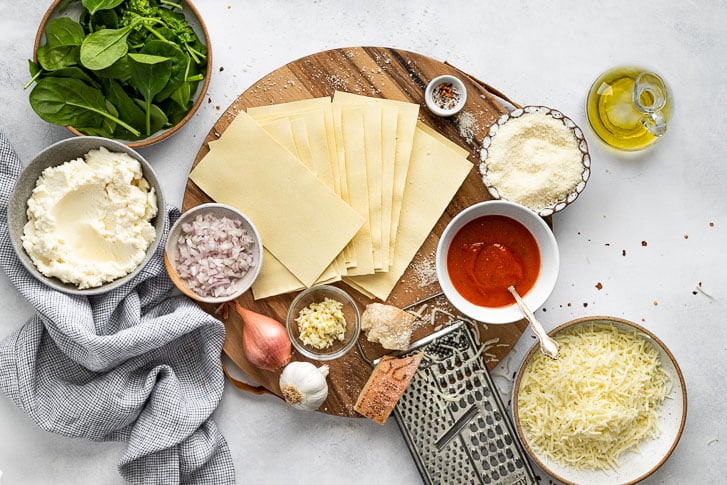
- Lasagna Pasta Sheets: more on this in a minute, because we are going to dive into the difference between using fresh pasta and dried pasta – either will work in this recipe.
- Butter: a little to grease the pan and a little more to saute the aromatics.
- Shallot: similar to an onion, it’s milder in flavor and a little sweeter. I love the flavor it brings in this recipe. If you need to substitute, use a finely chopped yellow onion.
- Garlic: ha! You know garlic pasta is basically my love language, and we were not making this without it!
- Spinach: I recommend using fresh baby spinach leaves, however, you can also use frozen if you need to, just be sure to read the notes on how to use frozen spinach in this lasagna.
- Ricotta Cheese: whole milk ricotta will bring the most flavor and creaminess to this recipe, although others will work if needed.
- Mozzarella Cheese and Parmesan Cheese: I definitely recommend using freshly grated cheeses because they melt the best!
- Salt, Pepper, and Red Pepper Flakes: as always, salt your food properly for the most flavor. This also means taste testing to be sure you’re on track. Just like pepper and red pepper flakes, add some for flavor!
- Nutmeg: my secret ingredient for ricotta cheese fillings; a pinch goes a long way and adds a unique flavor and depth that you don’t necessarily notice, but it gives it that “what is that deliciousness” kind of taste.
- Egg: binds together the filling; you could skip it if you need to, but just know the ricotta filling will be meltier.
- Tomato Sauce: I highly recommend making homemade sauce for the most flavor. You can even make it ahead of time and freeze it so you have it on hand. Your favorite jarred tomato sauce or marinara sauce will also work.
What kind of lasagna noodles should I use?
There are two noodle types to consider: fresh homemade pasta (or store-bought refrigerated fresh pasta sheets) or dried lasagna noodles.
Fresh Pasta Lasagna Noodles
Years ago I first made this homemade spinach lasagna recipe with homemade lasagna noodles… FRIENDS! It was life-changing. And I 1000% recommend making this lasagna using homemade lasagna sheets.
The homemade pasta sheets are thinner than dried noodles, so they meld with the sauce so beautifully. Not to mention, their flavor and texture are unbeatable.
To use made-from-scratch pasta, make my homemade pasta recipe, roll out the sheets to the thinnest (or second thinnest) setting, and cut them into sheets to fit your pan. They don’t need to be cut perfectly. Then, you’ll par-boil the noodles before assembly.
I’ll admit, it is a little more labor-intensive to use homemade pasta noodles, so it can be reserved for Sunday night family dinners or special occasions, but when you have time, it’s absolutely worth it.
Dried Oven-Ready Lasagna Noodles
To use dried noodles, I recommend buying high-quality no-boil lasagna noodles (they’re flat ones without ridges). This takes even more prep time out of the equation because, well, most obviously because you don’t need to boil any noodles.
If you do have regular dried lasagna noodles, follow the directions to par-boil them before assembly.
How to Use Fresh Pasta in Lasagna
Ok, so you want to use fresh pasta in this lasagna (YAY!) but how do you do it? It’s easy, it just requires a few more steps.
The fastest route would be to buy fresh lasagna pasta sheets at the store, which are typically found in the refrigerated section. I’ve found that Whole Foods usually has the best options (or another specialty store) depending on the stores in your area.
If you are making homemade pasta, first make the dough and let it rest. Once it has rested, roll out the dough according to the directions in the post. Roll the rectangle out on the second to last or thinnest setting for best results.
Once the sheets are rolled out, place them on a flour-lined countertop or surface and cut them into lasagna sheet size…which you can totally wing, in my opinion.
Bring a large pot of salted water to a boil, then boil the noodles for approximately 30 seconds, until they just start to float.
The goal is to par-boil them so they’re not entirely cooked all the way through. This allows for them to finish cooking while the lasagna bakes, without over-baking and becoming mushy.
Remove them from the water and place them on a tea towel (or paper towels) to dry while you continue with the rest of the steps.
How to Make the Spinach Ricotta Filling
Please remember to see the recipe card below for the full instructions.
Before we can assemble the lasagna, we have to make the ricotta filling. Start by melting butter in a large skillet. Saute the shallot, garlic, and spices, then in goes the roughly chopped spinach to wilt down.
We are roughly chopping the spinach before sauteing it so that the leafy pieces incorporate throughout the filling and are nicely bite-size.
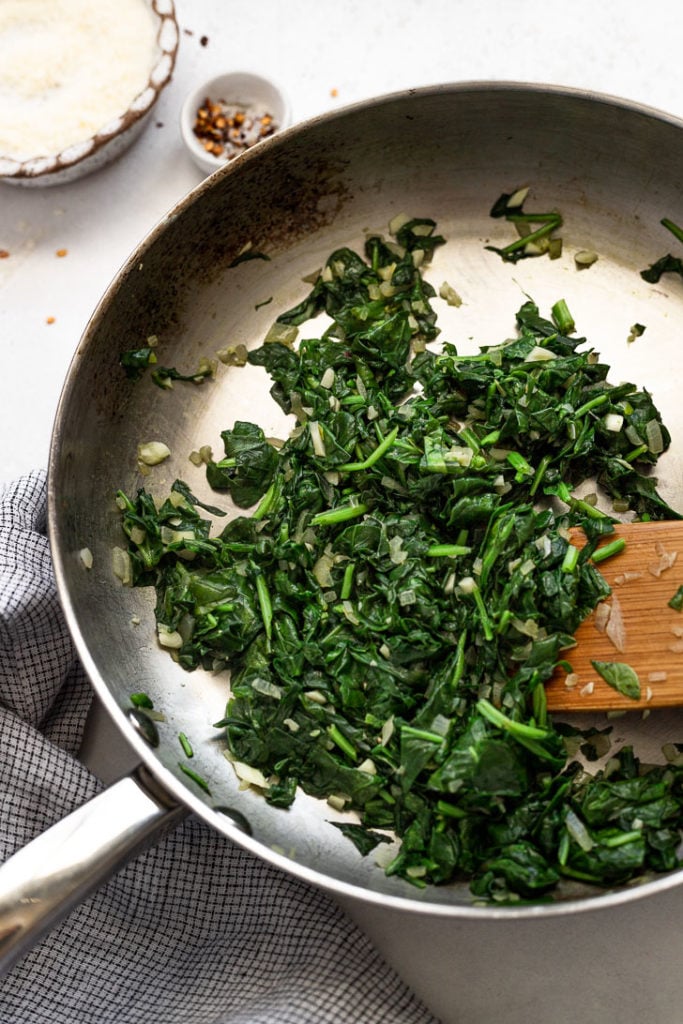
Once the spinach has wilted, transfer it to a fine-mesh sieve so any excess liquid from the spinach can drain out. Use the back of a spoon to press it down, if needed, to help it drain. If you don’t drain or squeeze the spinach, the excess water will make the lasagna runny.
While the spinach drains, stir together the ricotta, parmesan cheese, some mozzarella, nutmeg, and salt and pepper.
At this point, taste-test the ricotta cheese to make sure the salt levels are right before you add in the egg.
With the excess water out of the spinach, stir it into the ricotta mixture until combined, and now it’s time to assemble!
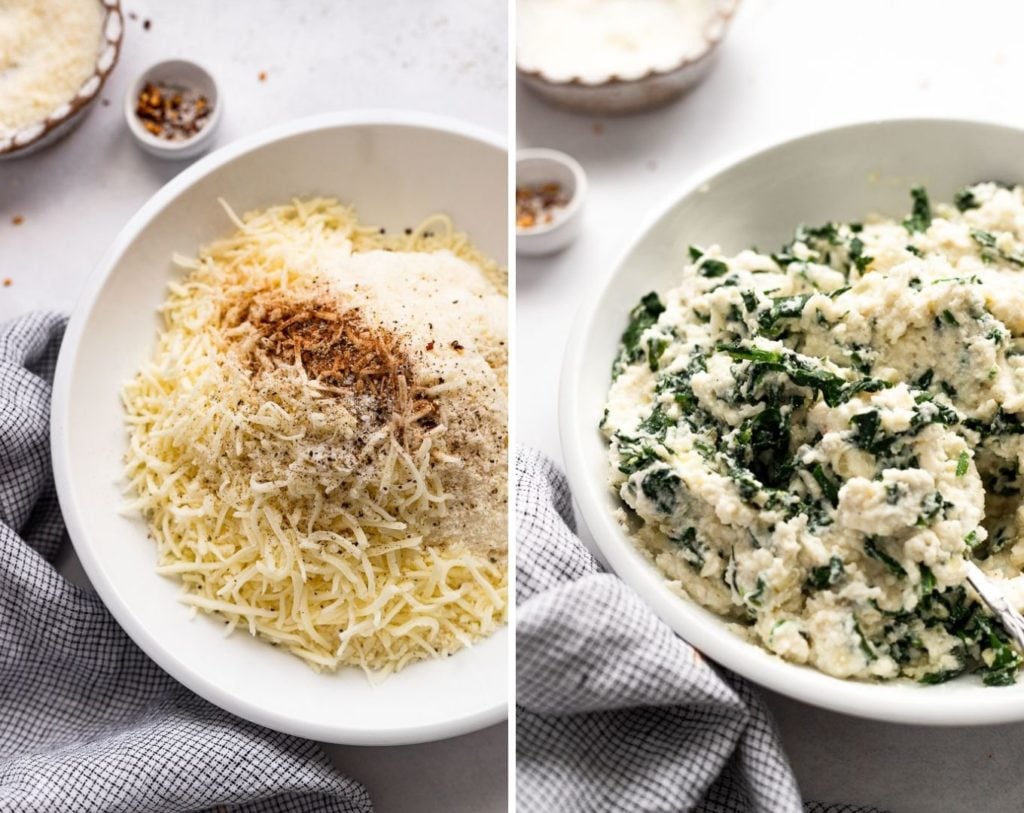
How to Assemble Vegetarian Lasagna with Ricotta
This is a smaller-batch lasagna (ok, it’s still enough for a family but not a 9×13 pan size!) that is made in an 8×8 or 9×9 baking dish (meaning glass or ceramic). It’s perfect for 2 with leftovers for a few lunches or dinners, or for 4 to 6 hungry people.
First, grab your pan and do a quick smear of softened butter to grease the sides and corners to prevent any lasagna from sticking. Then, for a similar purpose and to keep the noodles moist, spread a layer of sauce on the bottom of the pan.
Next, add a layer of pasta sheets. You can break or cut the pasta sheets to fit across the entire bottom of your pan. As shown here, I am using the no-boil noodle method.
On top of the noodles, spread about 1/3 of the ricotta mixture (or 1/4 if you want more layers). Then sprinkle on mozzarella cheese, and on top of the cheese, spread more tomato sauce.
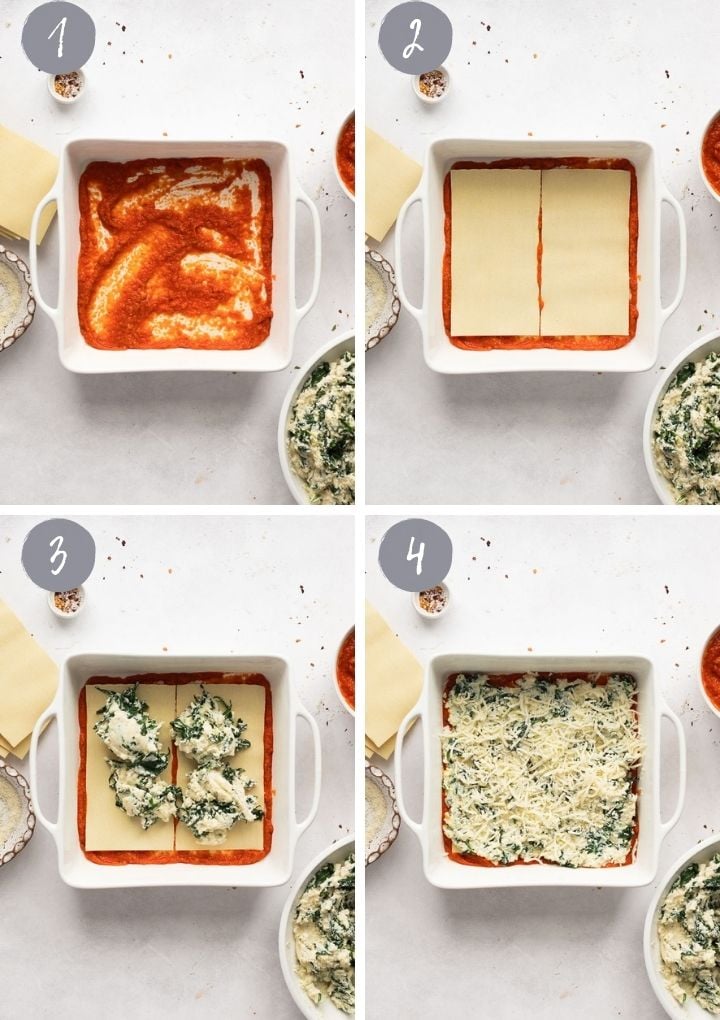
Continue layering on the pasta and filling until you have reached 3 or 4 layers, this is the order after the tomato sauce goes:
- lasagna noodles
- ricotta and spinach mixture
- shredded mozzarella
- tomato sauce
- repeat
I generally like to do three layers in the lasagna, or you can do 4 layers (as pictured) for a pasta-heavy lasagna.
To finish, end with a layer of pasta on top and spread tomato sauce over the noodles, with more mozzarella cheese for a cheesy topping.
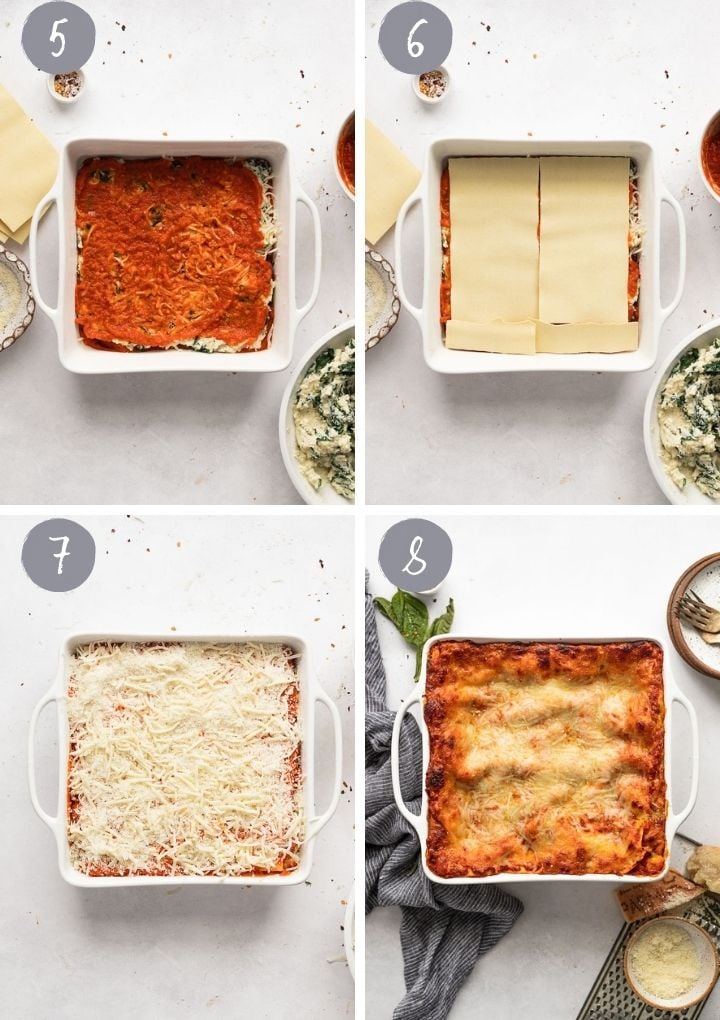
Baking Lasagna
Once the lasagna is assembled in the pan, you can bake it immediately or place it in the fridge for up to a day (more tips on that to follow!).
Cover the pan with aluminum foil for the first half of the baking time to ensure that the cheesy top doesn’t brown too quickly. Then, remove the foil and finish baking it uncovered until the cheese is golden brown and the edges are bubbly.
It’s best to let the lasagna sit for about 10-15 minutes (or more) before serving. This gives it time to set up so it’s easier to serve and helps it cool a little. I know, the wait is so hard!
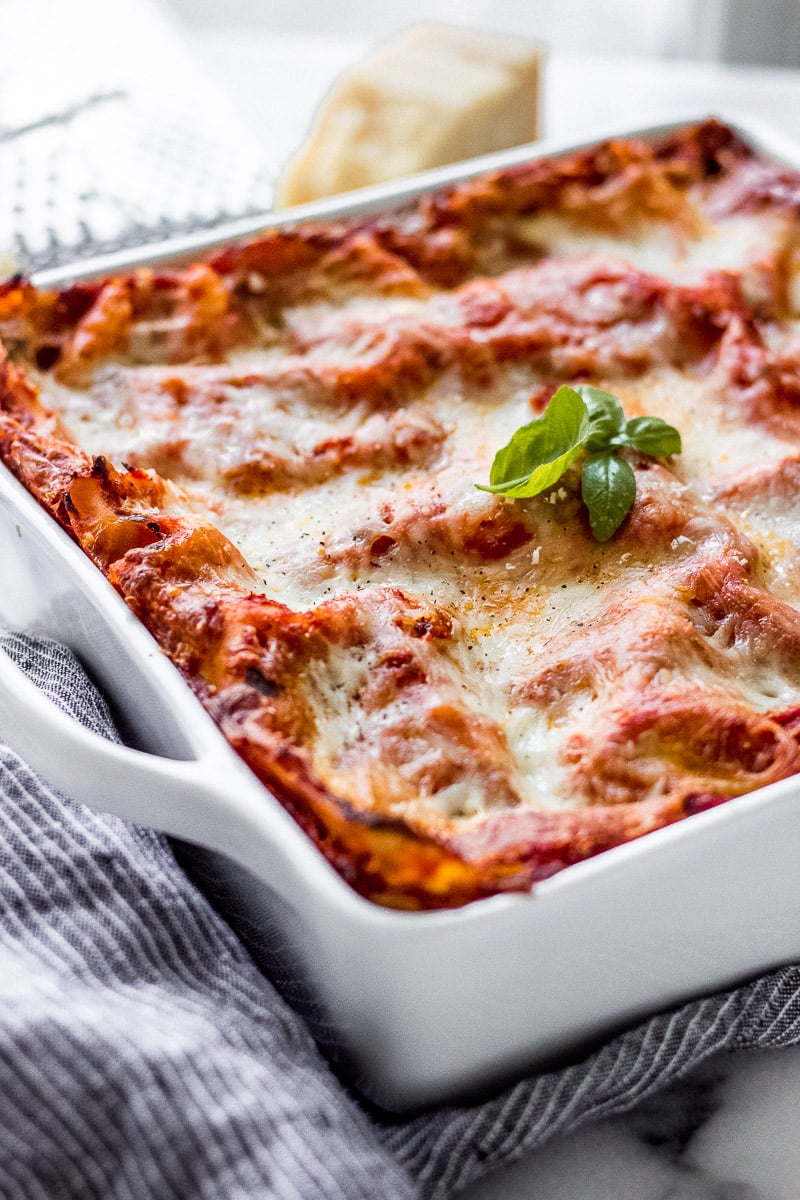
Make it Ahead of Time
As I mentioned, you can assemble the lasagna ahead of time. Just cover it and store it unbaked in the fridge for up to a day.
When you’re ready to bake, allow the pan to come to room temperature while the oven preheats (you don’t want to shock the cold pan or it will break). Then, bake as directed. It may take a little longer if the center of the lasagna is still cold.
You can also just make the filling and pasta one day ahead of time, storing them separately until you are ready to assemble.
Freezing & Cooking Frozen Lasagna
To freeze unbaked lasagna wrap it tightly and freeze it in the pan. It’s easiest to use a disposable aluminum foil pan if you don’t want to keep your pan in the freezer for too long. Also a great option for gifting lasagna to friends and family.
- Cooking thawed lasagna – thaw the pan in the fridge overnight so that it thaws completely. Do not thaw it at room temperature. Bake according to directions, covered with foil for the first half of the cooking time. You may need to add an extra 10 minutes or so, until it is bubbly and golden brown.
- Cooking frozen lasagna – to bake it straight from the freezer, remove any plastic wrap, then cover it with a piece of foil. Bake for 45-50 minutes covered, and another 20-25 minutes uncovered until hot and bubbly. If it seems to be browning too quickly, keep it covered. Make sure it’s cooked through to an internal temperature of 165°F.
Recipe Variations
There are many ways you can mix up the ricotta filling in this recipe.
- Use kale, arugula, or other hearty greens with or in place of the spinach.
- Add mushrooms, zucchini, or roasted bell pepper to the spinach – just be sure to saute them first before adding the spinach.
- Use a variety of cheeses in the mozzarella layer – try fontina, provolone, or Asiago.
- Replace half of the ricotta with cottage cheese.
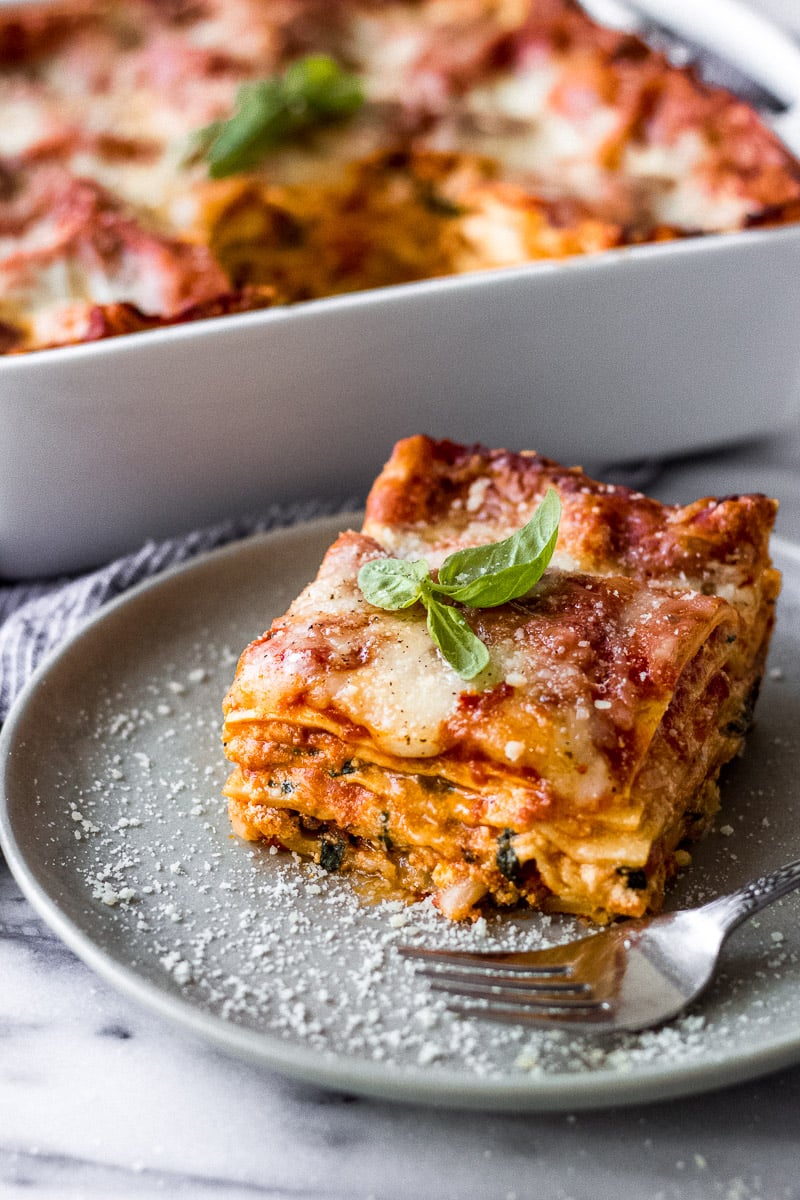
What to Serve with Veggie Lasagna
I love serving a (big) slice of spinach ricotta lasagna with Caesar Salad and a glass of Chianti. Or Sangiovese. Or really, any good, dry, full-bodied red will do.
It would also pair well with veggie sides like roasted broccolini, sauteed green beans and mushrooms or air-fried Brussels sprouts. For an additional main, try it with our 5-star vegetarian meatballs. And if you really want to go all out, serve a side of garlic herb dinner rolls with it, too. There’s no wrong way to enjoy this dinner recipe!
Did you make this recipe? Please leave a star rating and review in the form below. I appreciate your feedback, and it helps others, too!
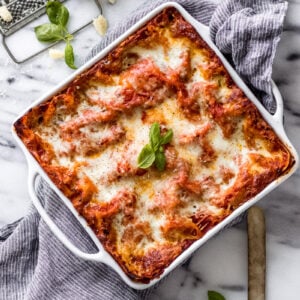
Get the Recipe Homemade Vegetarian Lasagna with Spinach Ricotta
Ingredients
- 9 ounces no-boil lasagna sheets, refrigerated fresh pasta sheets, or homemade pasta dough
- 1/2 Tablespoon unsalted butter, or olive oil
- 2-3 Tablespoons shallot, finely chopped (1 medium bulb)
- 4 garlic cloves, finely chopped
- Red pepper flakes, to taste
- 8 ounces fresh spinach leaves, roughly chopped
- 15 ounces whole milk ricotta cheese
- ¾ cup parmesan cheese*, shredded, divided
- 1 ½ cups mozzarella cheese, shredded, divided
- ½ teaspoon fine sea salt
- Freshly ground black pepper, to taste
- Pinch ground nutmeg
- 1 egg, slightly beaten
- 2 ¼ cups homemade tomato sauce, or jarred marinara; more as desired
Instructions
- Homemade Pasta: If using homemade pasta, roll out pasta sheets on the thinnest, or second to thinnest, setting, cutting them to fit the size of your pan. Bring a large stockpot full of salted water to a boil; par-cook the noodles for approximately 30 seconds, until they float. Transfer directly to an ice bath, remove, then set them to dry on a tea towel or paper towels. Let them rest until ready to assemble the lasagna. If using refrigerated pasta sheets or no-boil (oven-ready) dried lasagna noodles, use as directed…generally no need to prep!
- Pre-heat oven to 375°F. Grease an 8×8 or 9×9 baking dish (glass or ceramic) with softened butter or cooking spray. Set aside.
- Spinach Mixture: In a large skillet, melt butter over medium-high heat. Add chopped shallot and let cook for 2-3 minutes. Add garlic and continue to cook for 1-2 minutes. Season with red pepper flakes, salt, and pepper to taste. Add chopped spinach to skillet, stir to coat, and remove from heat as spinach wilts. Transfer to a fine-mesh strainer and press to release all liquid from the spinach. Set aside to drain and cool. See notes below for using frozen spinach.
- Ricotta Filling: Meanwhile, in a medium bowl stir together ricotta, ½ cup parmesan cheese, ¾ cup mozzarella cheese, ½ teaspoon fine sea salt, black pepper, nutmeg. Taste test to check for salt and spice levels, then stir in the egg. Once the spinach has drained and cooled, stir it into the ricotta mixture.
- Assembly: Spread ¼ cup of tomato sauce in greased baking dish. Place down the first layer of lasagna sheets; top with approximately ⅓ of the ricotta mixture (for 3 layers), then an additional ¼ cup shredded mozzarella, and ½ cup tomato sauce. Continue with two more full layers: pasta, ricotta, mozzarella, sauce. Once the three layers of ricotta are set, top with a final layer of pasta and tomato sauce. Sprinkle the remaining mozzarella cheese (~1/3 cup) and remaining parmesan (~1/4 cup) on top.
- Bake: Cover the pan with foil and bake for 25 minutes. Remove foil and continue baking for 20-30 additional minutes, until golden brown and bubbly around the edges. Let sit for 10-15 minutes, then cut slices and serve. Garnish with additional parmesan cheese or fresh basil as desired.
Notes
- Frozen spinach: if using frozen spinach, thaw and squeeze out all excess moisture (use a lot of paper towels to help!) before adding to the shallot mixture.
- Gluten-Free: Republic makes gluten-free refrigerated pasta, available in grocery stores! Barilla also makes an oven-ready, no-boil lasagna sheet gluten-free.
- Store any leftovers in an airtight container in the fridge for up to 4 days. You can also freeze leftovers; thaw in the microwave then finish reheating in the oven if desired.
- Prep Time: if making homemade pasta, expect an additional 15 minutes of prep time, plus 30 minutes of rest time for the dough.
- Layers: feel free to do 4 layers to have a more pasta-forward lasagna.
- *Look for cheese specifically labeled vegetarian, if needed.

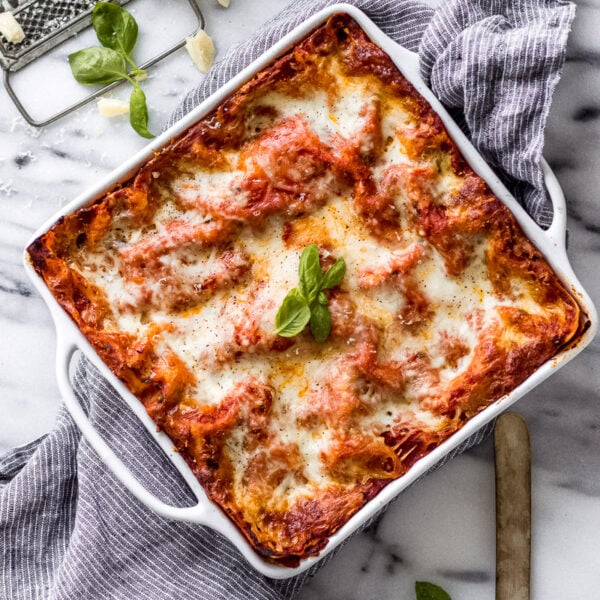




I made this for dinner tonight, it was so easy and delicious. I used premade uncooked lasagna noodles and it turned out fine. Perfect for a December weeknight.
So glad you loved it! Thanks for commenting, Stephanie!
May I ask did you remove the garlic and shallots from the pan before you started cooking the spinach?
Many thanks
Stefanie
Hi Stefanie – nope, I leave the shallots and garlic in the pan and stir the spinach in with them. Enjoy!
Love this vegetarian lasagna! It’s a hit with my entire family!
I have fresh lasagna sheets made locally… do i cook them for 30 seconds before using them. they are made with eggs.
Hi Phyliss – great question! From what you described, yes, I would go ahead and follow the directions for homemade pasta and par-cook them for 30 seconds before using. Let me know how it turns out!
Didn’t you have anyone proofread your recipe? You called for only 8 ounces of spinach. The recipe for spinach lasagna on my box said 8 CUPS of spinach. That’s more like it. The directions for your Ricotta filling never mentions adding the Ricotta. I quit following your recipe and used the recipe on my Kroger lasagna box. It also called for 2 eggs, not 1. And I agree with the other recipe that marinara sauce is tastier than using plain tomato sauce. I wonder if you will keep my review visible.
Hi Esther, I’d love to clear a few things up for other readers, and then you are more than welcome to follow the recipe on your Kroger box, because the beauty of life is that we can make the recipes we like best, and adjust them to our liking.
If you read under instruction 4 with the bolded “ricotta filling” title, the first sentence says “in a medium bowl stir together ricotta…” and continues listing the rest of the filling ingredients. While I do use the words “tomato sauce” if you clicked the link, or read the information in the post, you would know that I am in fact referring to marinara sauce, not plain tomato sauce, but thank you for pointing that out as I will make that more clear.
At the end of the day, please keep in mind that we are all humans and kindness is truly the best policy. I will keep your review visible, because I do hope it helps others, if in no other way than to remind us all of that.
Buon Apettito!!!!! Delicious…I added some shredded carrot as well !!!!
What a yummy addition! Thanks, for making and leaving a comment, Erin, I’m so glad you enjoyed!
I made this recipe almost as given, quadrupled it. Used chopped kale instead of spinach and added sauteed mushrooms and thinly sliced zucchini to each layer. Proportions and cooking times were right on. Thanks.
Awesome, thank you so much for sharing!
It was delicious 😋
I’m so happy you enjoyed it! Thanks, Tanya!